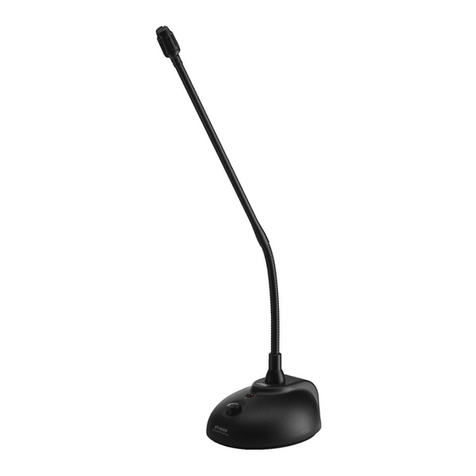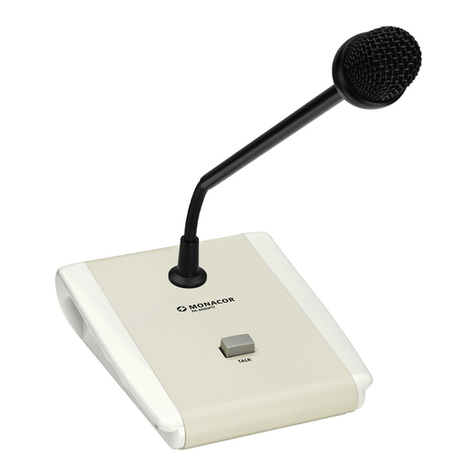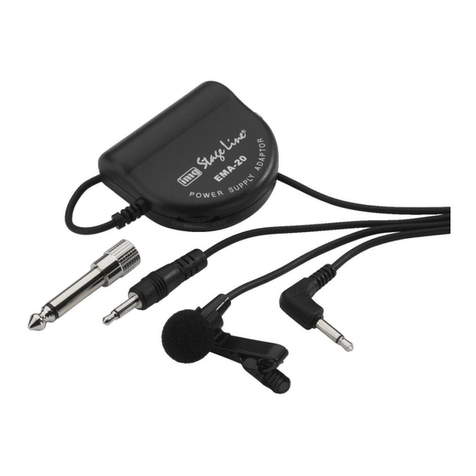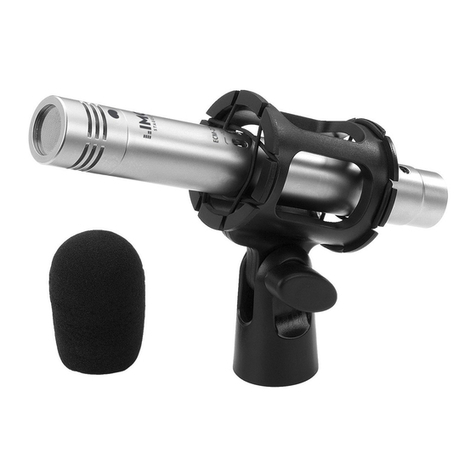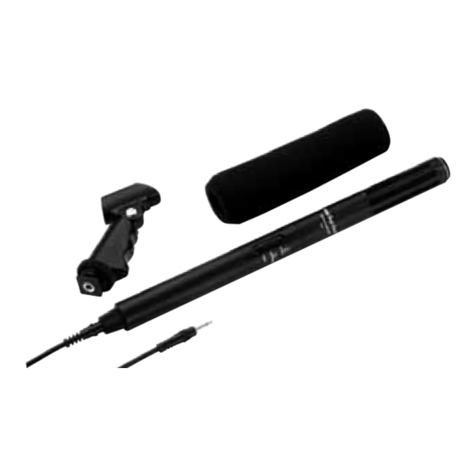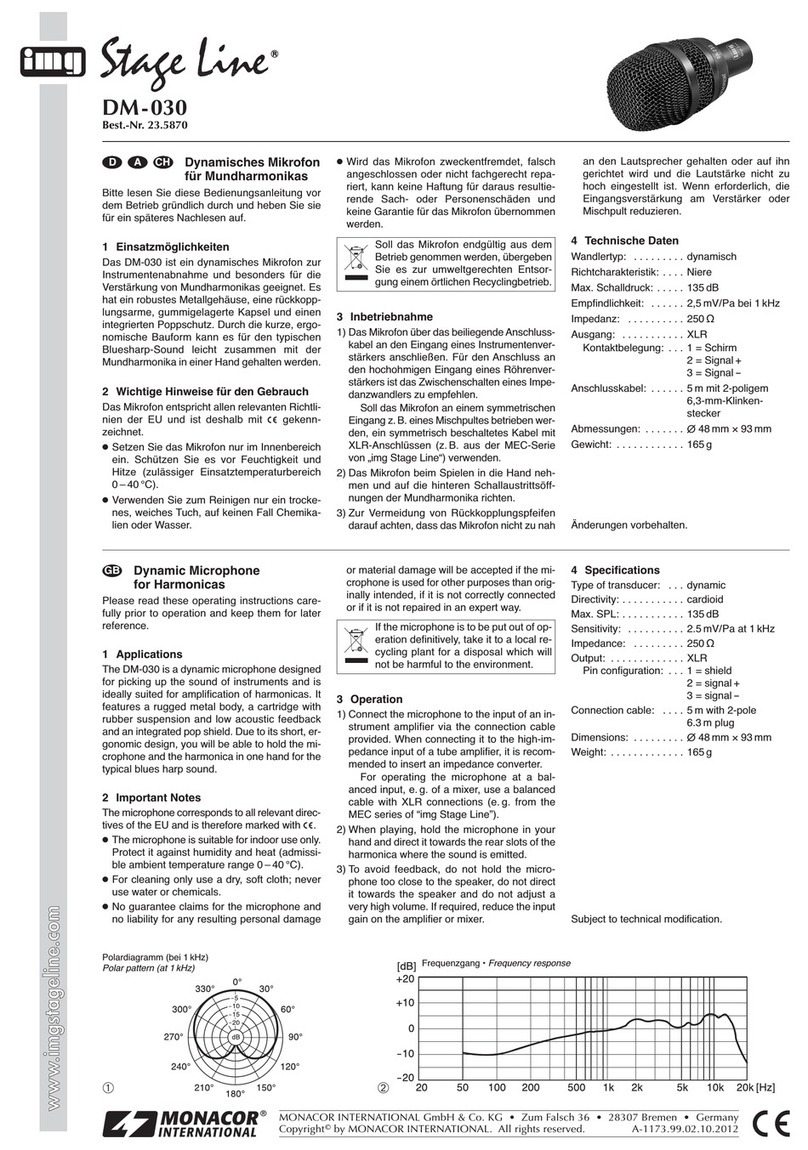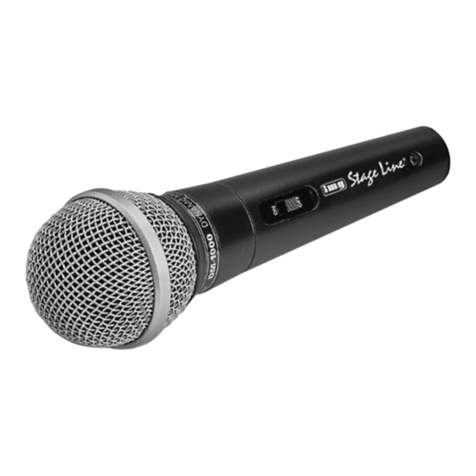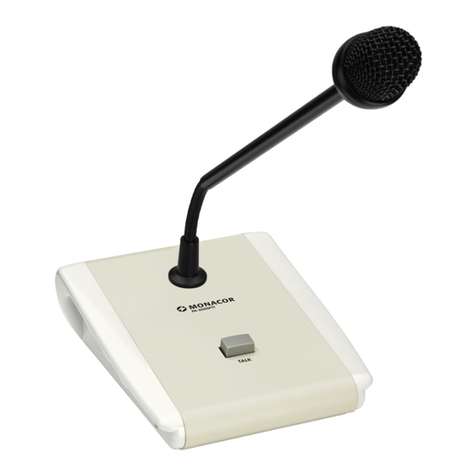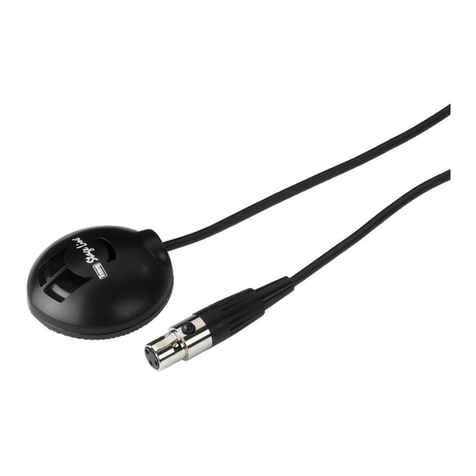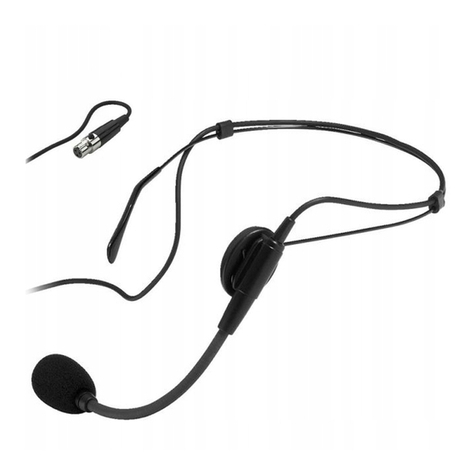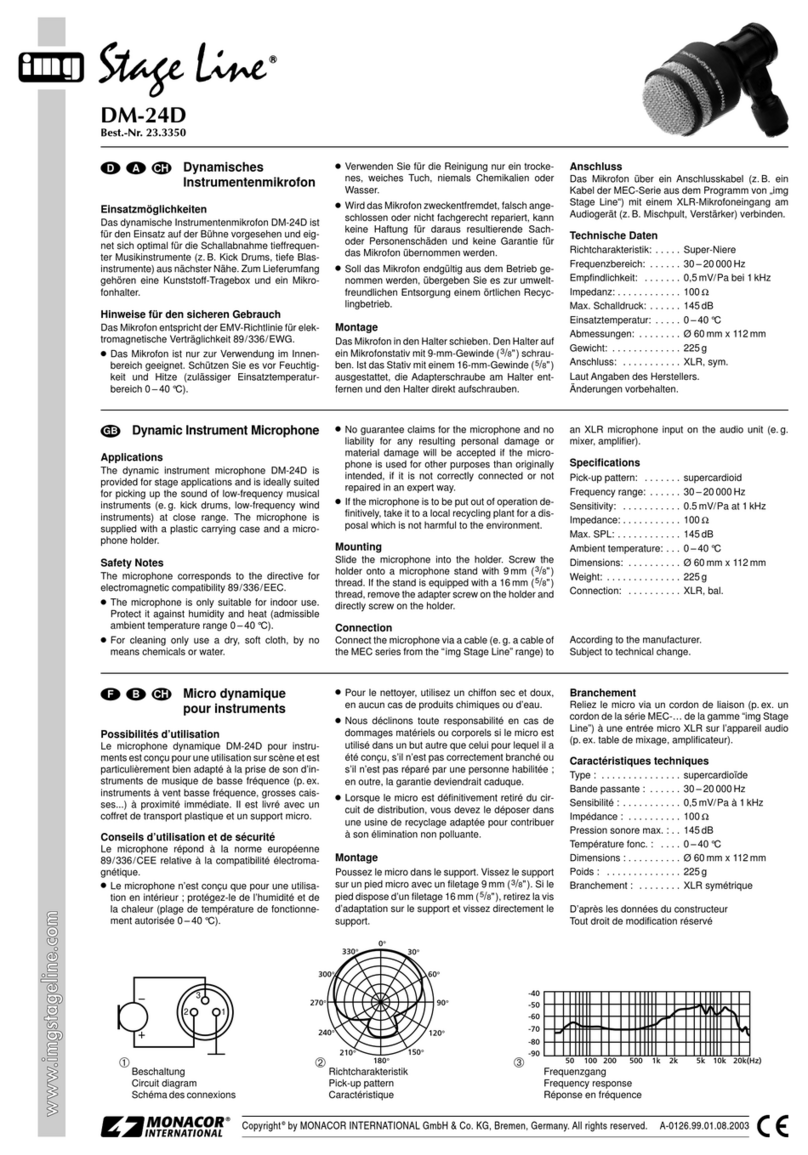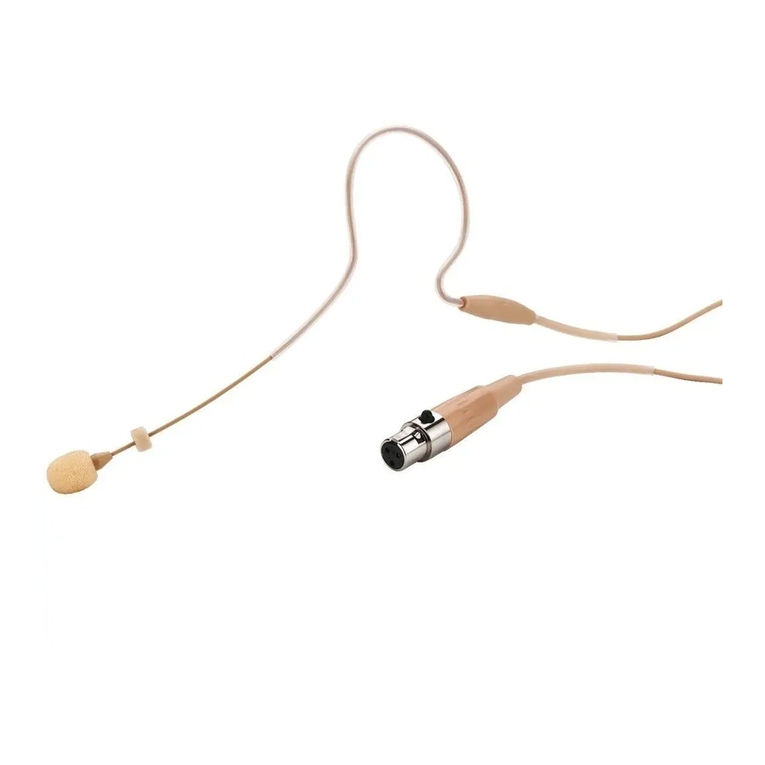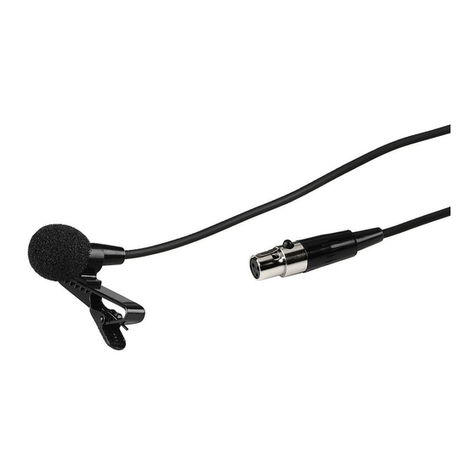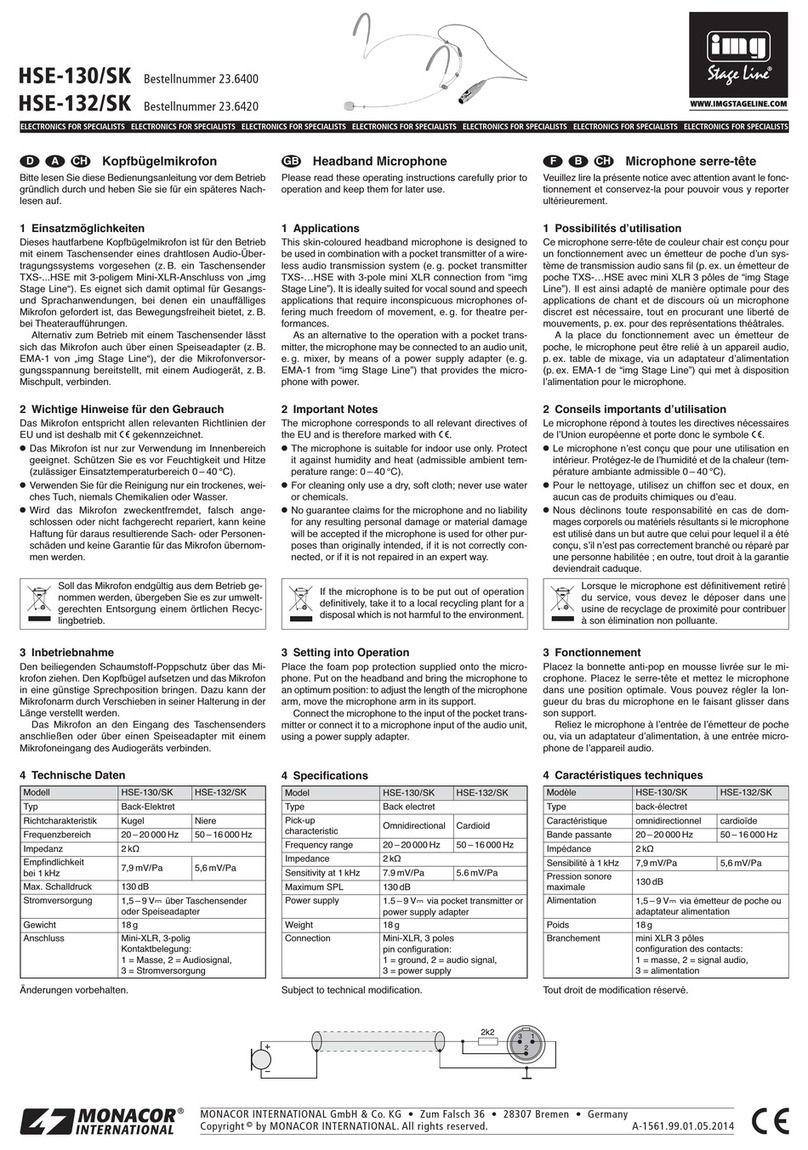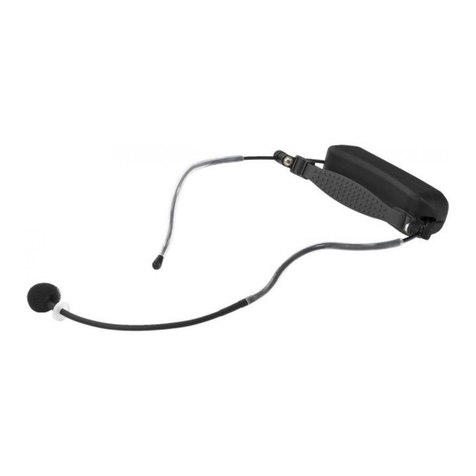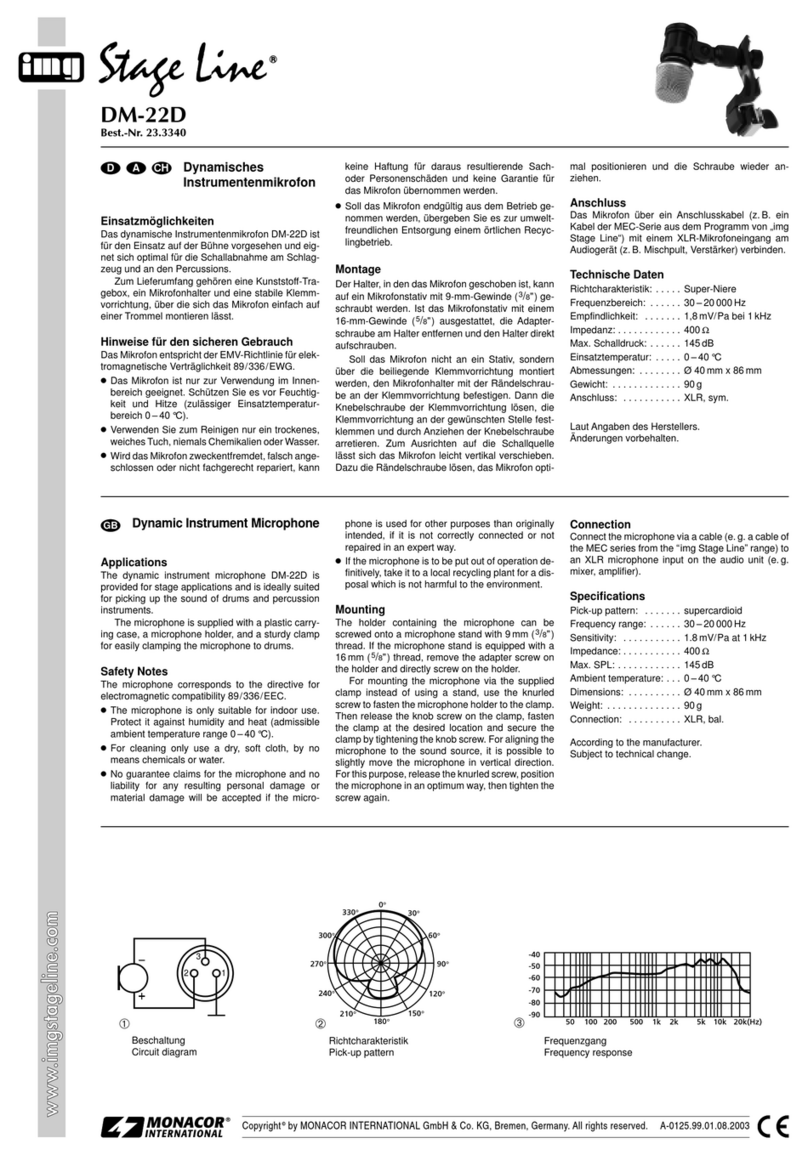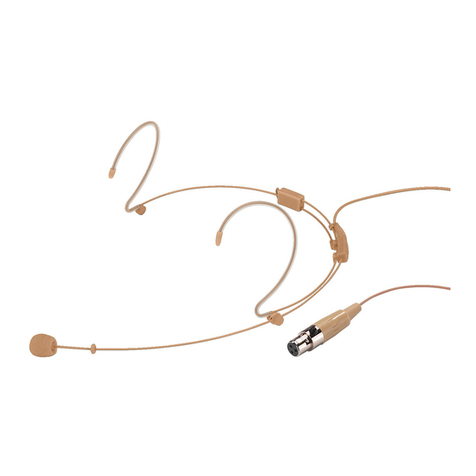wwwwww..iimmggssttaaggeelliinnee..ccoomm
Microfono headset
Vi preghiamo di leggere attentamente le presenti
istruzioni prima della messa in funzione e di con-
servarle per un uso futuro.
1 Possibilità dʼimpiego
Il microfono headset HSE-3… è adatto in modo
ottimale per applicazioni di canto e di lingua par-
lata che richiedono molta libertà di movimento.
Per il funzionamento è richiesta una tensione con-
tinua fra 1,5 V e 9 V. A tale scopo sono disponibili,
dal programma di “img Stage Line”, specialmente
per il modello HSE-310/SK un adattatore di ali-
mentazione (p. es. EMA-1, EMA-300P) oppure,
per la trasmissione audio senza fili, un trasmetti-
tore tascabile (TXS-...HSE).
2 Avvertenze di sicurezza
Il microfono è conforme a tutte le direttive rilevanti
dellʼUE e pertanto porta la sigla .
GFar funzionare il microfono solo allʼinterno di
locali e proteggerlo dallʼacqua gocciolante e
dagli spruzzi dʼacqua, da alta umidità dellʼaria e
dal calore (temperatura dʼimpiego ammessa fra
0 e 40 °C).
GPer la pulizia usare solo un panno morbido,
asciutto; non impiegare in nessun caso prodotti
chimici o acqua.
GNel caso dʼuso improprio, di collegamenti sba-
gliati o di riparazione non a regola dʼarte del
microfono, non si assume nessuna responsabi-
lità per eventuali danni consequenziali a per-
sone o a cose e non si assume nessuna garan-
zia per il microfono.
3 Messa in funzione
1) Applicare la protezione antivento.
2) Sistemare il microfono headset in testa e por-
tare la capsula del microfono vicino alla bocca
in una posizione adatta per parlare. A tale
scopo, il braccio del microfono può essere pie-
gato in tutte le direzioni.
3) Collegare il microfono con lʼapparecchio a
valle, vedi illustrazione. Eventualmente inserire
un adattatore di alimentazione.
Se si desidera eliminare il microfono defi-
nitivamente, consegnarlo per lo smalti-
mento ad unʼistituzione locale per il rici-
claggio.
Micro diadema
Por favor, lea este manual de instrucciones deta-
lladamente antes de hacer funcionar la unidad y
guárdelo para una futura utilización.
1 Aplicaciones
El micro de diadema HSE-3… está especialmente
diseñado para sonido vocal y aplicaciones de habla
que requieren mucha libertad de movimiento. Para
el funcionamiento es necesaria una tensión DC
entre 1,5 V y 9 V. Especialmente para el modelo
HSE-310/SK un adaptador de alimentación (p. ej.
EMA-1, EMA-300P) o para transmisión inalámbrica
un transmisor de petaca (TXS-...HSE) están dispo-
nibles dentro de la gama “img Stage Line”.
2 Notas de seguridad
El micro cumple con todas las directivas relevan-
tes de la UE y es por esto que está marcada
con .
GEl micro ha estado diseñado solamente para la
utilización en el interior. Protéjalo contra las sal-
picaduras y las proyecciones de agua, una alta
humedad del aire y del calor (temperatura de
ambiente admisible 0 – 40 °C).
GPara la limpieza utilice únicamente un trapo
seco y suave, nunca utilice productos químicos
o agua.
GLa unidad carecería de todo tipo de garantía en
caso de daños personales o materiales resultan-
tes de una utilización de la unidad con otro fin del
que le es propio, si no está correctamente conec-
tada o no ha estado reparada por un experto.
3 Puesta en funcionamiento
1) Coloque la protección anti viento.
2) Póngase el micro de diadema y coloque la cáp-
sula del micro de manera que le quede cerca
de la boca en una posición favorable para
hablar. Para hacerlo, puede mover el brazo del
micro en todas las direcciones.
3) Conecte el micro a la otra unidad, vea es-
quema. Si es necesario, utilice un adaptador de
alimentación.
Si el micro está definitivamente retirado
de servicio, llévelo a una planta de reci-
claje próxima para contribuir a su elimi-
nación no contaminante.
4 Especificaciones
Tipo de micro: . . . . . . . . back electret
Característica: . . . . . . . . cardioide
Índice de frecuencia: . . . 50 –18 000 Hz
Impedancia: . . . . . . . . . 2 kΩ
Sensitividad: . . . . . . . . . 2,3 mV/Pa a 1 kHz
Presión sonora máx.: . . 120 dB
Fuente de alimentación: 1,5–9V
Peso sin cable: . . . . . . . 18 g
Conexión:
Sujeto a modificaciones técnicas.
HSE-300/SK Best.-Nr. 23.4080 HSE-310/SK Best.-Nr. 23.4120 HSE-330/SK Best.-Nr. 23.0140
I
E
4 Dati tecnici
Tipo di microfono: . . . . . back-elettrete
Caratteristica
direzionale: . . . . . . . . . . cardioide
Gamma di frequenze: . . 50 –18 000 Hz
Impedenza: . . . . . . . . . . 2 kΩ
Sensibilità: . . . . . . . . . . 2,3 mV/Pa con 1 kHz
Pressione sonora max.: 120 dB
Alimentazione: . . . . . . . 1,5–9V
Peso senza cavo: . . . . . 18 g
Collegamento:
Con riserva di modifiche tecniche.
®
MONACOR INTERNATIONAL GmbH & Co. KG
•
Zum Falsch 36
•
28307 Bremen
•
Germany
Copyright
©
by MONACOR INTERNATIONAL. All rights reserved. A-0449.99.02.08.2013
Mikrofon nagłowny
Prosimy o uważne przeczytanie poniższej instruk-
cji przed użyciem urządzenia, oraz o zachowanie
tekstu do wglądu.
1 Zastosowanie
Mikrofon nagłowny HSE-3… jest mikrofonem wo-
kalowym (do zastosowań muzycznych oraz kon-
ferencyjnych). Jest idealny do zastosowania tam,
gdzie potrzebna jest duża swoboda ruchu. Do
poprawnej pracy wymagane jest zasilanie prądem
stałym (1,5 – 9 V). W ofercie “img Stage Line”
dostępne są zasilacze do mikrofonu HSE-310/SK
(np. EMA-1, EMA-300P) lub nadajnik kieszon-
kowy do bezprzewodowej transmisji akustycznej
(z serii TXS-...HSE).
2 Bezpieczeństwo użytkowania
Ponieważ urządzenie spełnia wymogi obowiązujące
w Unii Europejskiej, jest oznaczone symbolem .
GUrządzenie jest przeznaczone do użytku tylko
w pomieszczeniach. Urządzenie należy chronić
przed działaniem wody, wysokiej wilgotności
powietrza oraz wysokiej temperatury (dopusz-
czalna temperatura otoczenia pracy 0 – 40 °C).
GDo czyszczenia urządzenia należy używać
suchej, miękkiej tkaniny; nie należy stosować
wody ani środków czyszczących.
GProducent ani dostawca nie ponoszą odpowie-
dzialności za wynikłe szkody (uszkodzenie
sprzętu lub obrażenia użytkownika), jeśli
urządzenie było używane niezgodnie z prze-
znaczeniem, niewłaściwie zainstalowane lub
obsługiwane, albo jeśli było poddawane nieau-
toryzowanym naprawom.
3 Przygotowanie do pracy
1) Należy założyć na mikrofon osłonę przeciw-
wietrzną/zabezpieczającą.
2) Należy założyć mikrofon na głowę, umieścić
wkładkę mikrofonową blisko ust w wygodnej
pozycji. W tym celu można poruszać ramie-
niem mikrofonu we wszystkich kierunkach.
3) Należy podłączyć mikrofon do podłączyć
gniazdo nakablowe typu mini XLR do gniazda
nadajnika kieszonkowego lub zasilacza (zasi-
lacz należy następnie połączyć z wejściem
urządzenia audio). W razie potrzeby należy
podłączyć zasilacz.
Jeśli urządzenie ma zostać ostatecznie
wycofane z użycia, należy przekazać je
do punktu utylizacji odpadów, aby unik-
nąć zanieczyszczenia środowiska.
4 Dane techniczne
Typ mikrofonu: . . . . . . . mikrofon elektretowy
Charakterystyka
mikrofonu: . . . . . . . . . . . kardioidalna
Pasmo przenoszenia : . 50 –18 000 Hz
Impedancja: . . . . . . . . . 2 kΩ
Czułość: . . . . . . . . . . . . 2,3 mV/Pa przy 1 kHz
Maks. SPL.: . . . . . . . . . . 120 dB
Zasilanie: . . . . . . . . . . . 1,5–9V
Waga (bez kabla): . . . . . 18 g
Podłączenie:
Z zastrzeżeniem możliwości zmian.
PL
